
Dig Dug is a maze arcade video game released by Namco in 1982. It was distributed in North America by Atari, Inc. The player digs underground tunnels to attack enemies in each level, by either inflating them to bursting or crushing them underneath rocks.
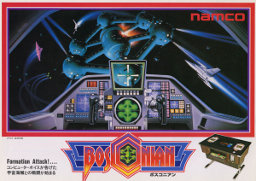
Bosconian is a scrolling multidirectional shooter arcade video game developed and released by Namco in Japan in 1981. In North America, it was manufactured and distributed by Midway Games. The goal is to earn as many points as possible by destroying enemy missiles and bases using a ship which shoots simultaneously both the front and back.
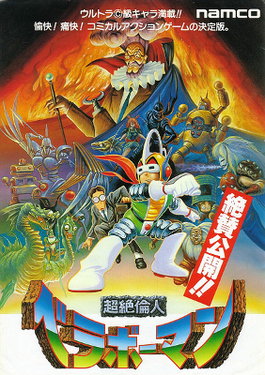
Chōzetsurin Jin Bravoman is a 1988 beat'em up arcade video game developed and published in Japan by Namco. Described as a "comical action game", the player controls the titular character, a bionic superhero with telescopic limbs, as he must defeat the villainous Dr. Bomb before he takes over the world. Bravoman can use his arms, legs and head to defeat enemies, and can also crouch and jump over them. The game ran on the Namco System 1 arcade board.

The Tower of Druaga is a 1984 arcade action role-playing maze game developed and published in Japan by Namco. Controlling the golden-armored knight Gilgamesh, the player is tasked with scaling 60 floors of the titular tower in an effort to rescue the maiden Ki from Druaga, a demon with eight arms and four legs, who plans to use an artifact known as the Blue Crystal Rod to enslave all of mankind. It ran on the Namco Super Pac-Man arcade hardware, modified with a horizontal-scrolling video system used in Mappy.

Fatal Fury Special, known as Garō Densetsu Special in Japan, is a 1993 fighting game developed and published by SNK and originally released for the Neo Geo arcade and home platforms. It is an updated version of 1992's Fatal Fury 2, introducing several changes to the gameplay system while expanding the available character roster.

Marvel Land is a platform game released by Namco in arcades in 1990. It runs on the Namco System 2 hardware. The game was published for the Mega Drive in 1991, with the European version renamed Talmit's Adventure. The game shares its name with the fictitious kingdom where the 1986 Japan-only Famicom game Valkyrie no Bōken: Toki no Kagi Densetsu takes place, but has no connections with it otherwise. Likewise the game has no connections with Marvel Comics or any of their associated characters either. In December 2022, the arcade version of Marvel Land was re-released exclusively in Japan on the Nintendo Switch and the PlayStation 4 on the Arcade Archives lineup of digital arcade titles. It was originally planned for worldwide release at one point but was ultimately cancelled due to licensing issues with Disney and Hamster Corporation.

Galaga '88 is a 1987 fixed shooter arcade video game developed and published in Japan by Namco and in North America and Europe by Atari Games. It is the third sequel to Galaxian. It features significantly improved graphics over the previous games in the series, including detailed backgrounds, larger enemies and greater ship details. The game runs on Namco System 1 hardware.

Dragon Spirit is a 1987 vertical-scrolling shooter arcade game developed and published by Namco. In North America, it was distributed by Atari Games. Controlling the dragon Amur, the player must complete each of the game's nine areas to rescue the princess Alicia from the demon Zawell. Similar to Namco's own Xevious, Amur has a projectile weapon for destroying air-based enemies and a bomb for destroying ground enemies. It ran on the Namco System 1 arcade board.

Genpei Tōma Den is a side-scrolling hack and slash video game produced by Namco that was released as a coin-operated video game in 1986 in Japan. It runs on Namco System 86 hardware. Over a decade later, the game was released in America and Europe in the video game compilation Namco Museum Vol. 4 under the title of The Genji and the Heike Clans for the PlayStation.

Yōkai Dōchūki is a 1987 platform arcade game developed and released by Namco in Japan and other parts of Asia. The player controls a young boy named Tarosuke as he must make his way through Jigoku, the Japanese concept of Hell, to reach Buddha, who will determine his fate. Tarosuke can fire small "ki" bullets at enemies to defeat them; he can also charge them to increase their power. Enemies will drop money when defeated, which can be used to purchase weapons and other items in stores. Two versions of the arcade original were released: a Japanese version and an English version which was released in other Asian countries outside Japan. The Arcade Archives release includes both versions.
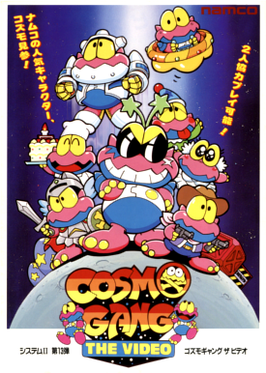
Cosmo Gang the Video is a 1992 fixed shooter arcade game developed and published by Namco. A home conversion for the Super Famicom was released the same year. Controlling the Hyper Beat starship, the player is tasked with ridding the galaxy of the Cosmo Gang, a race of aliens that cause mischief across Earth. Gameplay involves shooting enemies and avoiding projectiles. Power-up items can be collected to grant the player additional abilities. It ran on the Namco System 2 arcade board.
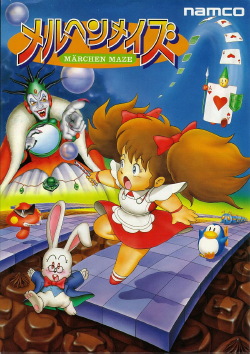
Märchen Maze is a 1988 isometric platform arcade game developed by N.H. System and published by Namco. Controlling a young girl named Alice, the player must complete each of the game's nine stages while avoiding enemies and falling off ledges. Alice can blow powerful bubbles at enemies to knock them back, and can hit them enough times to send them off the platform. It is the first Japanese video game adaptation of Lewis Carroll's Alice's Adventures in Wonderland, and runs on the Namco System 1 arcade board.
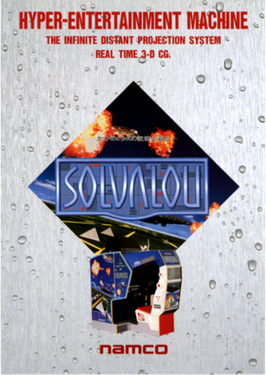
Solvalou is a 1991 first-person rail shooter arcade game developed and published in Japan by Namco. The sixth entry in the Xevious series, the player takes control of the Solvalou starship from a first-person perspective as it must destroy the Xevious forces before they take control of Earth. The Solvalou has two weapon types: an air zapper to destroy air-based enemies, and a blaster bomb to destroy ground-stationed enemies. It runs on the Namco System 21 arcade board.

Kyūkai Dōchūki is a baseball arcade game that was released by Namco in 1990 in Japan; it runs on Namco System 2 hardware, and is a spin-off of Yokai Dochuki. The gameplay is similar to Namco's own World Stadium series, except that both players have a total of thirty-six different teams to choose from in the Japanese, Arabic, German, Humbaba, American, Russian, and Chinese leagues. The Japan League has five stadiums, and if the player selects one team from it, the game will randomly decide which stadium the match will take place in, but the other leagues only have one stadium. This game also features a cameo re-appearance, from Valkyrie, who appears to report the final outcome of a match once it has finished. Namco's signature character Pac-Man can also be seen on two of the television screens in a studio wearing a purple bow tie.
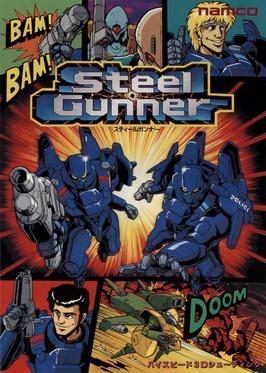
Steel Gunner is a 1990 first-person shooter arcade game developed and published by Namco. Players take control of Garcia and Cliff, a duo of police officers that are part of the Neo Arc police force, as they must use their powerful Gargoyle mecha suits to destroy the STURM terrorist organization, who have taken captive scientists Dr. Ryan and Dr. Ellis to create a world-ending superweapon. Gameplay revolves around using a crosshair to shoot down enemies and avoid harming civilians. It runs on the Namco System 2 Plus arcade hardware.

Xevious: Fardraut Saga is a 1988 vertically scrolling shooter video game published by Namco for the MSX2 in Japan. An updated PC Engine version was released two years later. The fifth entry in the Xevious franchise, the player controls a spaceship in its mission to vanquish the Xevious forces before its supercomputer leader GAMP wipes out the entirety of mankind. The player uses two weapons, an air zapper to destroy air-based enemies, and a blaster bomb to destroy ground-based enemies.
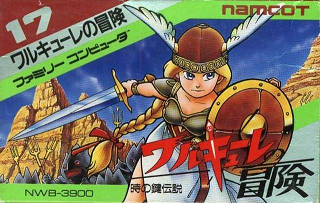
Valkyrie no Bōken: Toki no Kagi Densetsu is a video game developed and published by Namco. It was released in Japan for the Family Computer on August 1, 1986. It was also released for the Virtual Console of multiple Nintendo consoles, for the Wii on March 20, 2007, for the Nintendo 3DS on September 4, 2013 and for the Wii U on February 4, 2015.
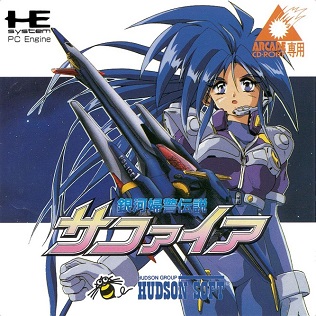
Ginga Fukei Densetsu Sapphire, commonly abbreviated to Sapphire in English, is a shoot 'em up developed by CAProduction for the PC Engine CD-ROM² System. It was published in 1995 by Hudson Soft exclusively in Japan. The story follows an all-women police force in 2092 traveling through time to intercept terrorists committing crimes across the past and future. The player takes on the role of a police officer and controls their spaceship through waves of enemies and powerful bosses.

Whirlo is a side-scrolling action-platform released by Namco on July 23, 1992 in Japan for the Super Famicom video game system, and in Europe and Australia later during the same year. The game was re-released on August 1, 1998 in Nintendo Power flash RAM cartridge format.
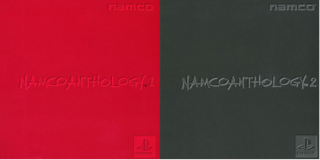
Namco Anthology is a 1998 duology of video game compilations developed and released by Namco for the PlayStation exclusively in Japan. The two collections compile several Namco-published video games for the Family Computer, Super Famicom, and Mega Drive, in a manner similar to the company's existing Namco Museum series. Alongside ports of the original games are remakes of each game that feature enhanced graphics, sound, and gameplay.






















